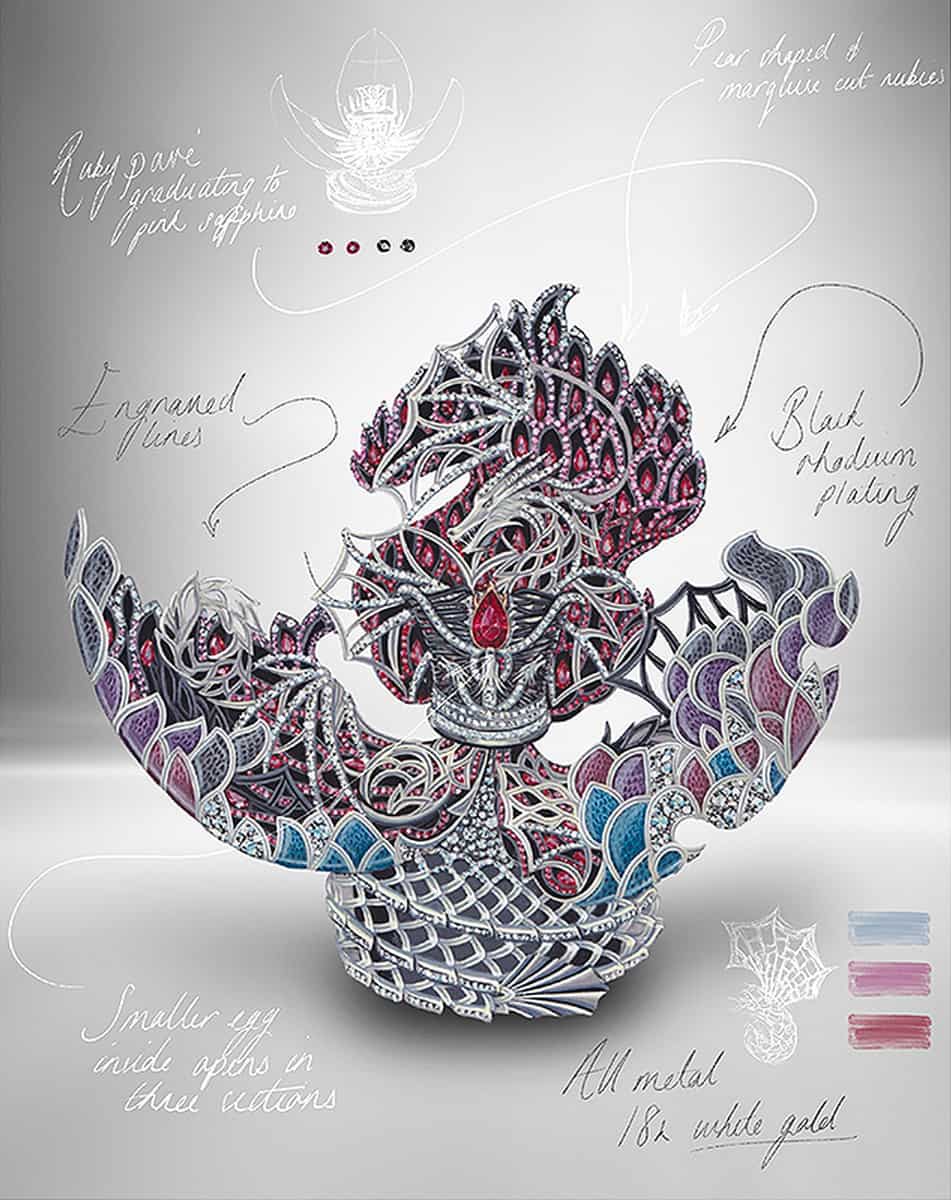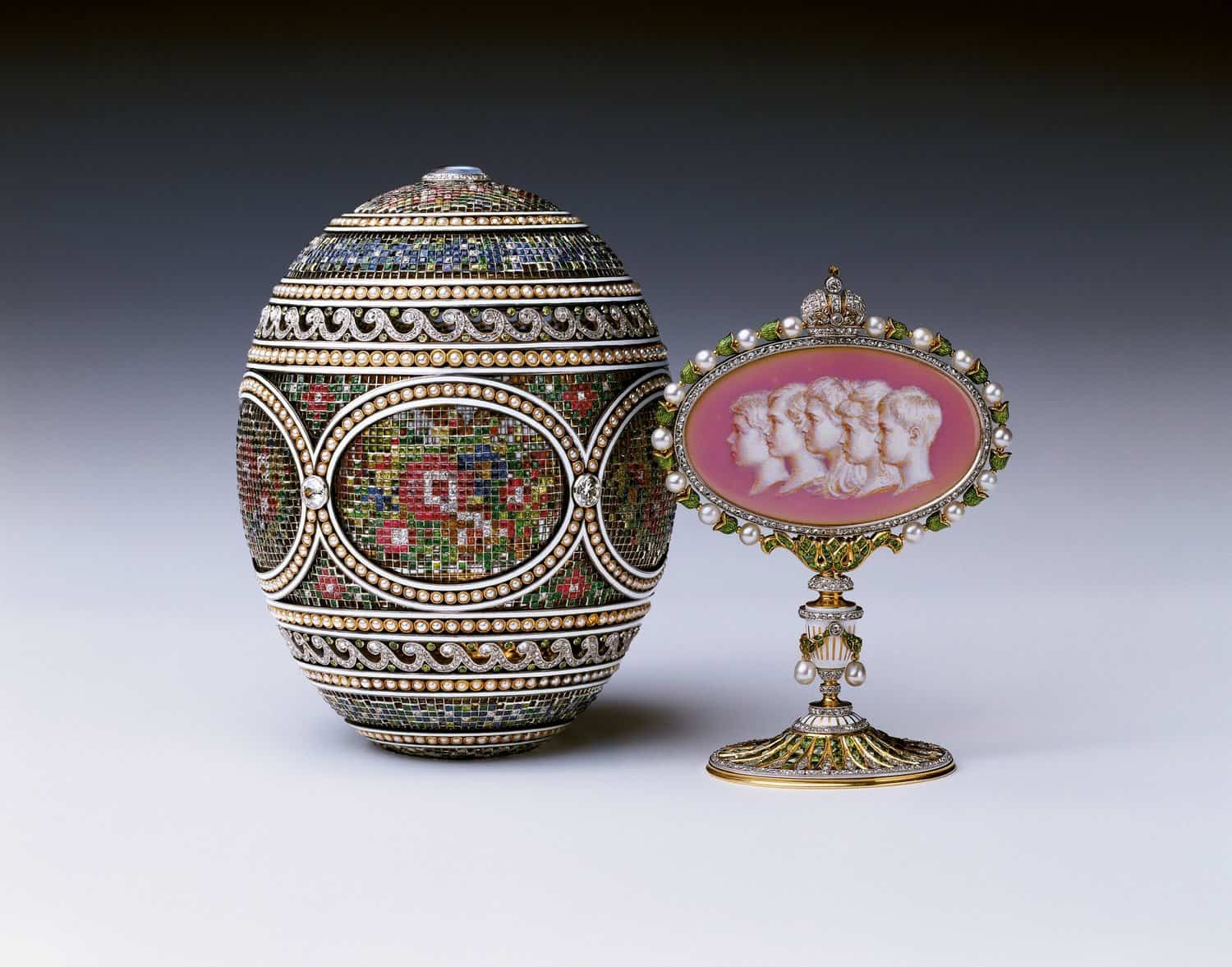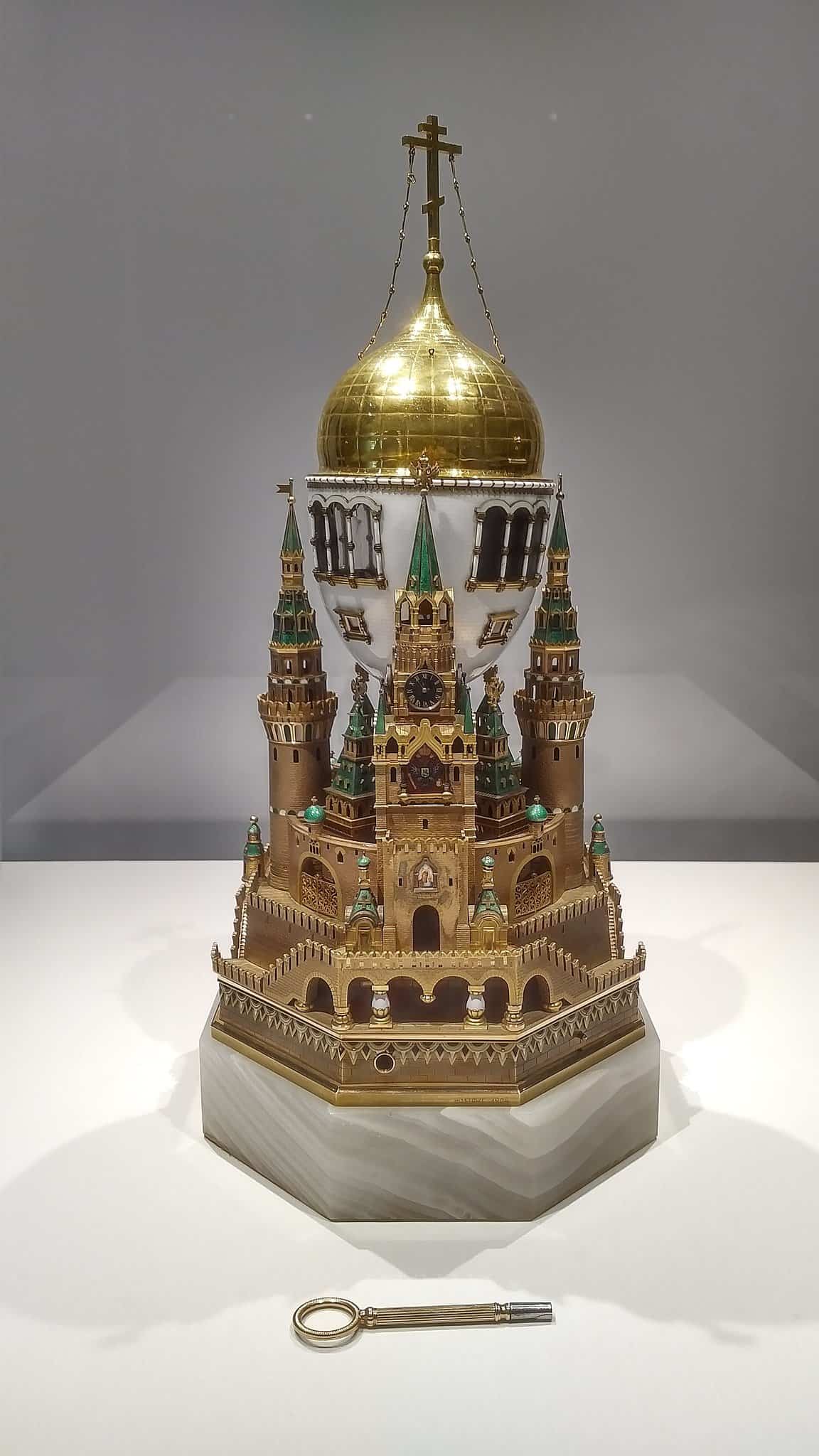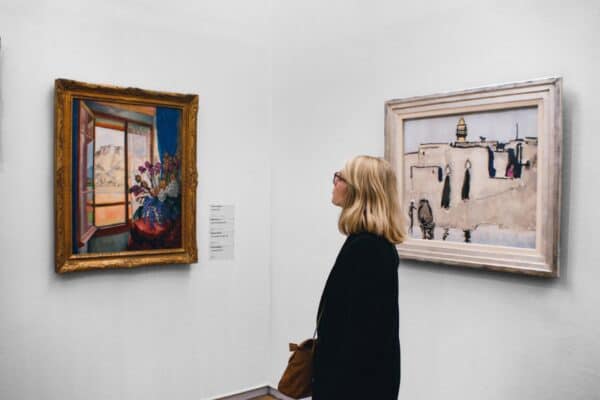The famous jewelry firm House of Fabergé is the company behind these extraordinary and rare collectibles that we call Fabergé Eggs. Handcrafted from rare materials and carefully decorated with precious gemstones, they are intricate works of art that are sometimes worth more than most of our homes.
The Faberge eggs were created between 1885 and 1917 in Russia, at the request of the Tsars that were reigning at the time, Alexander lll and Nicholas ll. The Russian Tsars first commissioned these works of art as gifts to their mothers and wives.
What Exactly are Fabergé eggs?
In case you’re not familiar with them, Faberge eggs are collectible pieces that are shaped like an egg but made from valuable and rare materials. Every single egg created is unique. They were produced in Russia by Peter Carl Faberge as Easter gifts to the Russian aristocracy.
The French jeweler was commissioned as court jeweler to the Tsar to create one egg per year during their reigns. He was also responsible for other decorative items such as portrait frames and boxes, but the eggs are without a doubt his most expensive creation.
Why Are They so Expensive?
Since they are mainly made out of rare gemstones and precious metals their price is justified, but their rarity is also a factor.
Only 69 Faberge eggs have been originally created and just 57 of them survive today. From those, 52 of them were part of the special “Imperial collection“, only 46 of them surviving until today.
Associated with aristocracy and wealth, the Faberge eggs have a rich history, which makes them highly sought after. These creations are simply exquisite, made with a superior attention to detail and unique characteristics.
Faberge History
The Faberge family is originally from France, and commonly used the name Favri there. They are from the Northern part of France named Picardy. Gustav Faberge moved to Russia in the 1840s, where he founded the Faberge jewelry firm back in 1842. But his son, Peter Carl Faberge, was the one who designed and created the famous eggs when he took over the business in 1872.
In Russian Orthodox tradition, exchanging colorful eggs at Easter is a long-standing custom. Hence, Tsar Alexander lll ordered a jeweled egg from the court jeweler, Peter Carl Faberge to give to his wife, Maria Feodorovna.
Since the Tsarina loved her gift, it became a yearly tradition for the jeweler to create a unique egg for her every Easter. As the years passed, Faberge gained the title of “Supplier to the Imperial Court”, which gave him freedom of design. He had three rules to follow: it had to be shaped like an egg, be different every year, and contain a surprise.
After the Russian revolution, the Faberge family fled since most of the Romanovs died, and many of the eggs were confiscated by the Bolsheviks. That is why some of them have never been recovered.
Let’s take a look at the 20 most expensive Fabergé eggs of all time.
20. The Basket of Flowers Egg
Made in 1901 for Emperor Nicholas ll’s mother, the Dowager Empress Maria Federovna, The Basket of Flowers egg is part of the Royal Collection. It is owned by Her Majesty The King of England. This particular model is crafted from enamel and gold, and it is adorned with diamonds, onyx and pearls.
19. Game of Thrones Egg
The latest addition to the Faberge egg collection, this iteration was created in April 2021. Inspired by the dragons from the popular TV series, an anonymous buyer purchased this beauty for just over $2 million before the artists even started their work. Daenerys’s dragons are replicated.
The Game of Thrones egg is made from sheets of 18k white gold and is adorned with thousands of precious gems in purple, gray, and blue tones.
18. The Yusupov Clock Egg

This egg is part of a private collection, which was owned by Prince Felix Yusupov and his wife Princess Zinaiada. Crafted in 1907 by workmaster Henrik Wigstrom, the Yusupov Clock Egg is made from enamel, gold, silver and white onyx, and adorned with diamonds, emeralds, pearls, and rubies.
When the original egg was given as a gift, it contained the portraits of Felix and their two sons, but those are lost today.
17. The Colonnade Egg
Crafted by Henrik Wigstrom in 1910, this egg is one of the three Faberge eggs the King of England owns. Part of the private Royal collection, the Faberge Colonnade egg was inspired by the temple that was built for Marie Antoinette in the Palace de Versailles.
With a rotating clock face, it has four gold cherubs at its base, representing Tsar Nicholas ll’s daughters. The cherub that is located at the top represents the Emperor’s son, while the two doves represent him and his wife.
16. The Duchess of Marlborough Faberge Egg
Created for Consuela Vanderbilt, who married Charles Spencer-Churchill, the ninth Duke of Marlborough, this fabulous egg is shaped like a clock. It was made specifically at her request after she visited the home of Tsar Nicholas ll in 1902.
The exquisite piece resembles a Louis XVI clock that has a revolving dial. The Duchess of Marlborough Egg was part of the sale where Viktor Vekselberg invested in nine Faberge eggs for his collection. It can be seen at the Faberge Museum in Saint Petersburg.
15. The Renaissance Egg
Gifted to Empress Maria Feodorovna in 1894 by her husband, Tsar Alexander lll, the Renaissance Faberge egg is the last one she ever received. As per custom it was supposed to contain a surprise, but it is no longer present.
Most likely the surprise was kept by the Empress at the time. Some speculate that the Resurrection egg was placed inside since it fits perfectly, but we cannot confirm this. This egg is also available for viewing at the Faberge Museum in Saint Petersburg.
14. The Resurrection Egg
This unique piece is the only one that makes reference to the religious story surrounding the Easter holiday. This is the surprise that is believed was included in the eggs Empress Maria Federovna received in 1894.
We are not sure if the theory holds any truth to it, but that is the rumor. The Resurrection egg is part of the nine eggs Viktor Vekselberg purchased. If you want to see it in person, the Faberge Museum in Saint Petersburg has it on display.
13. The Mosaic Egg
Back in 1914, when this extraordinary egg was created, this was the most expensive Faberge egg to date. The unique design of the Mosaic Egg includes a gold egg that is divided into five oval-panes that are shaped like a flower. With diamond and gold belts, the intricate design makes it one of the most sought after items.
It is now part of the Royal Collection of the King of England, and it was purchased by King George and Queen Mary for the meager sum of 250 British pounds. Last available viewing of this collectible was on display in 2011, as part of the Private Royal Collection.
12. The Moscow Kremlin Egg
The largest Imperial egg ever made, the Moscow Kremlin egg is over 14 inches high. Inspired by the cathedral where Nicholas ll was crowned in 1896, the egg’s design has a golden onion dome shape.
In the shell there are tiny windows that make it resemble the original landmark, while offering a view of the interior of the cathedral. It was meant to be presented to the Russian royal family in 1904, but due to the 1904-1905 Russo-Japanese war, it was only presented the following year, in 1906.
11. The Rosebud Egg
This is the first egg Tsar Nicholas ll commissioned as a gift to his wife, Empress Alexandra Feodorovna, back in 1895. With a design that is inspired by rosebuds, hence the name, the Rosebud Faberge egg contained a yellow enamel tea rose that was tucked inside. The red egg is stunning, covered in four strips of diamonds.
The original contained a ruby pendant that was hidden inside the tea rose, but that is no longer present. There was also a small gold crown, which is gone as well. This item is also available for viewing at the Faberge Museum in Saint Petersburg.
10. The Hen Egg
Although one of the most simple designs, this is one of the most expensive Faberge eggs ever. It is the first commissioned egg by Emperor Alexander lll back in 1885, that is why it is so special. With a minimalistic white and gold design, there is a golden hen that was placed inside as the surprise for Empress Maria Feodorovna.
The hen is now missing, but the Hen egg can be viewed at the Faberge Museum in Saint Petersburg. The designer is Peter Carl Faberge, while the workmaster is Erik Kollin.
9. Cradle With Garlands Egg
The birth of Tsar Nicholas ll’s son Alexei was celebrated with this egg, named the Cradle with Garlands. This monumental occasion started a new tradition for the Royal family. The Tsar gifted his wife Alexandra this pale blue-colored, pearl-encrusted egg for giving birth to his first son. Henrik Wigstrom is the artist that created this work of art.
The miniature imperial children that was tucked inside is now missing, but the egg sold in 1992 for the crisp sum of $3.19 million. Now it is worth almost double that, and it’s on display at the V7A Museum in London.
8. Order of St. George Egg
This is the highest military decoration in Russia. In order to commemorate the achievement, Tsar Nicholas ll and his son, Grand Duke Alexei Nikolaievick commissioned the house of Faberge to design an egg for the occasion in 1916.
While on the modest side, this superb Faberge egg is covered in a subtle green and cream design, with the Order of Saint George medal at the center. Its modesty is due to the period of austerity that World War l brought to the country.
7. Lilies of the Valley Egg
This egg is designed with an Art Nouveau style, and it was created in 1898 as a gift to Tsar Nicholas ll for his wife, Empress Alexandra Fyodorovna. Only two of the Faberge eggs are designed using this style, which makes it very valuable.
The Lilies of the Valley egg boasts one of the most intricate patterns with a pink enamel on a guilloche field, featuring many pearls that are placed on top.
The structure is supported by four golden legs, and inside a portrait of the Tsar and his two oldest daughters can be seen. The portraits can be raised by twisting the pearl button at the top.
6. Fifteenth Anniversary Egg
Tsar Nicholas ll celebrated his fifteenth anniversary of his coronation with this unique Faberge egg. On the exterior, 16 miniature portraits are surrounded by gold, green, and white touches that are trimmed with crystals and diamonds.
Although it commemorated a special occasion, it is believed that this particular egg did not contain a surprise inside, like most of the other iterations. It can be viewed at the Faberge Museum in Saint Petersburg.
5. Bay Tree Egg
This egg was presented to Tsar Nicholas ll’s mother, the Dowager Empress Maria Feodorovna, alongside the Fifteenth anniversary egg. The Bay Tree egg is adorned with a shell made from nephrite and covered in amethysts, diamonds, pearls, and rubies, and the design looks like a tree.
The interior opens by turning a small fruit-shaped level, and it reveals a songbird. This egg was designed in 1911 and while many thought it was an orange tree, we now know that it is a bay tree.
4. The Winter Egg
Designed by one of the few women jewelers at the time, Alma Pihl, who came from a family of master jewelers, the Winter egg is ice-cold stunning. The artist drew her inspiration from frost-covered windows from her uncle’s workshop. The snowflake theme is one of the most popular Faberge egg designs, which is still one of the most expensive collectibles to date.
Sporting a frosted glass design, the egg is studded with 1,660 diamonds. It was created in 1913 and it remains in circulation today. In 2002 it sold for $9.6 million, which is worth over $15 million today.
3. Imperial Coronation Egg
This is one of the most incredible Faberge eggs ever designed. This 1897 creation exemplifies the intricate details it contains. The exterior of the Imperial Coronation Egg is crafted in a yellow that matches the gold robe Tsarina Alexandra Fyodorovna wore on her coronation day.
On the inside, the surprise was a 18th century replica of the Imperial coach used by the Royal family. Even the smallest details such as the functional shock absorbers, moving wheels, and opening doors are just like the real-life model.
2. Rothschild Clock Egg
This is another example of a Faberge egg that was not commissioned by the Russian Imperial family. It was an engagement gift to Germaine Halphen from Beatrice Ephrussi de Rothschild. The Rothschild Clock egg is designed in a gorgeous pink enamel and it is encrusted with diamonds, gold, pearls, and silver details.
But the best part is that at the start of each hour, a cockerel appears at the top of the egg. It flaps its wings four times, nods its head three times, then a bell strikes. It can be seen at the Hermitage Museum in Saint Petersburg, and today it is worth more than $25 million.
1. Third Imperial Easter Egg
Made out of a solid 18k gold case that is decorated with diamonds and sapphires, this is the most expensive Faberge egg ever. Worth more than $33 million today, this egg was discovered in 2011 by a scrap dealer by accident. The Third Imperial egg is held by three sets of legs that resemble a corbel and ending in lion’s paws.
The other surprise is found on the inside. There is a real Vacheron Constantin 14k gold lady’s watch that features diamond-set hands, raising its worth. The egg was designed by August Holmstrom, and it is privately owned.
Final Thoughts
This sums up our list of the 20 most expensive Faberge eggs of all time. The world of Faberge eggs is a fascinating one, filled with so many intricate details, luxurious materials and rare gemstones, and a unique cultural and historical significance. The most expensive and valuable Faberge eggs are true works of art, and their sky high value reflects the skill and creativity of their makers.
From the stunning Imperial Coronation Egg to the remarkable Rothschild Egg, the most expensive Faberge eggs are priceless treasures, that offer a glimpse into the opulence and grandeur of a bygone era.
Whether they are prized by collectors, displayed in museums, or passed down through generations, these extraordinary eggs will continue to captivate and inspire people for years to come.
Contents
- What Exactly are Fabergé eggs?
- Why Are They so Expensive?
- Faberge History
- 20. The Basket of Flowers Egg
- 19. Game of Thrones Egg
- 18. The Yusupov Clock Egg
- 17. The Colonnade Egg
- 16. The Duchess of Marlborough Faberge Egg
- 15. The Renaissance Egg
- 14. The Resurrection Egg
- 13. The Mosaic Egg
- 12. The Moscow Kremlin Egg
- 11. The Rosebud Egg
- 10. The Hen Egg
- 9. Cradle With Garlands Egg
- 8. Order of St. George Egg
- 7. Lilies of the Valley Egg
- 6. Fifteenth Anniversary Egg
- 5. Bay Tree Egg
- 4. The Winter Egg
- 3. Imperial Coronation Egg
- 2. Rothschild Clock Egg
- 1. Third Imperial Easter Egg































